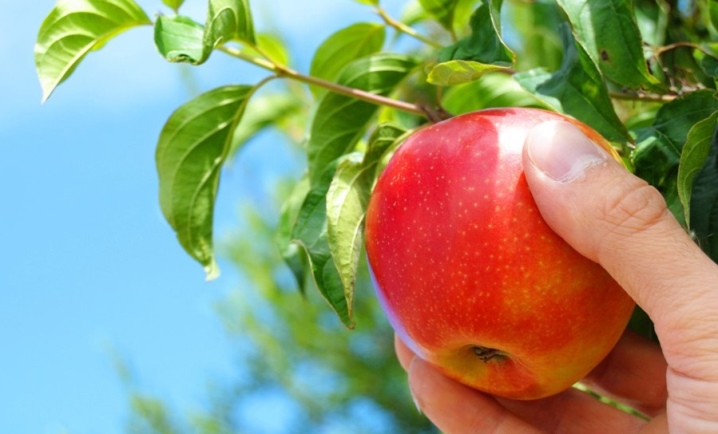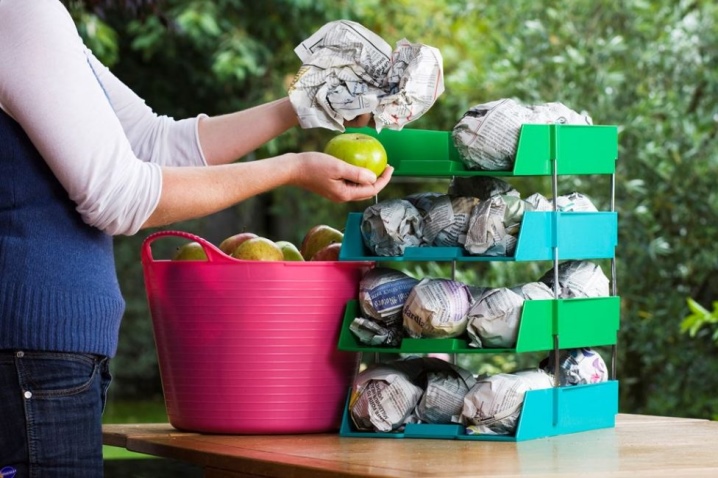When to remove winter apples for storage?

Despite the fact that picking an apple harvest is considered an elementary occupation, the correctness of its implementation largely affects the further safety of the fruits. In this case, it is necessary to take into account not only the timing, but also the technique.

How to determine ripeness?
Since late varieties ripen not on the branches, but already harvested for storage, they should be removed still hard and sour, containing a large amount of starch. The fruits should be moderately large, and the seeds should be colored in a rich brown hue. Another indicator that the fruit has reached the required ripeness stage is the ability to easily detach it from the branch without losing the petiole.
In principle, a careful study of fallen specimens will allow to determine the ripeness of winter apples - if there are large ones among them, the harvest is ready for harvest.
Experienced gardeners generally recommend focusing on the fruits lying under the tree - if the weather is calm, and high-quality specimens still end up on the ground, then it's time to collect them yourself.

There is also an easy way to simply sniff the apple. For winter varieties, it is important to have a very light aroma, since fruits that do not smell at all are unlikely to ripen in storage, and a bright smell is characteristic of a sample overexposed on the branches. As for the color, in fruits that have reached the moment of removable maturity, it rarely remains green - rather, it becomes yellowish and acquires a more pronounced blush. The appearance of a wax coating is also considered characteristic.
Novice gardeners can try to determine the onset of removable maturity by two indicators: apple density and starch content. The first parameter is determined by a special device called a penetrometer.

Usually, several samples are checked from the south and north side of the apple tree. An indicator of density or applied force is considered optimal for collection, equal to 7-7.5 kilograms per square centimeter.
The starch content is calculated as part of a small chemical experiment. The first step is to prepare the test preparation. It contains 10 grams of a 5% solution of iodine in alcohol, 80 grams of 2.5% potassium iodide and 410 grams of distilled water. Half an apple is dipped into the resulting mixture for about a couple of minutes. If the entire cut turns yellowish-whitish, it means that consumer maturity has come, and completely blue indicates that the fruit has not even reached removable maturity.
In the case of winter varieties, you should focus on the average value.

Collection time
All varieties of apple trees are usually classified into summer, winter and autumn. The timing of the harvesting of fruits largely depends on this classification, but it is also taken into account whether the apples will be stored or eaten fresh. Winter varieties have the maximum keeping quality and almost never get on the table directly from the tree. Before eating fruits, you have to wait for their maximum ripeness, which can come in a few months. In principle, such apples ripen right during storage, and some remain edible in early spring.
It is customary to remove winter apples for storage somewhere from late September to mid-October. However, all procedures should be completed before constantly low temperatures are established, and therefore often have to fit in an interval of less than a month. It is not only possible to pick off, but also it is necessary to not fully ripened fruits, since they reach the required condition already in the boxes. Of course, weather conditions can affect the time when it is time to harvest. For example, after a hot summer, apples will ripen earlier, and cold and rainy months will delay maturity by several weeks.

Often, even the specifics of the winter variety affect the timing of harvesting. For example, it is better to cut off large and weighty fruits of the Bogatyr variety in October, so that they have time to gain juice before the onset of cold weather. In artificially created conditions, they will ripen until the end of December. The Aport variety should be harvested in the last days of September. Enjoy the glossy fruits of bright red color in a month. The most popular "Antonovka" can be removed from the branches during September, and sweet and juicy apples "Jonathan" - only at the end of the first autumn month.
The picking periods for apples can vary greatly by region. So, in the middle lane, including in the Moscow region, harvesting for the winter can generally begin from mid-October. But the same "Antonovka" can be torn down earlier, already at the end of September. In the Urals and the Volga region, including in Saratov, apples are more often picked in September, while still being tough, greenish and “wadded”.

How to harvest correctly?
The removal of winter fruits from apple trees is carried out in accordance with a well-proven scheme. The procedure should be carried out on a warm day, not spoiled by rain, and even more so snow. You have to start acting after lunch, when the dew dries up. Trees the day before should not be watered, and the apples themselves should remain dry. First, the gardener will need to remove the fruits from the lower branches, and then, gradually moving upward, reach the top of the tree.
In order not to damage the delicate skin of the fruit, it is better to work with latex gloves.

Fruits that are too high are obtained with the help of special devices, for example, a kind of apple "bucket" on a long stick or a hook that allows you to attract branches to yourself. In principle, it will be possible to get by with a simple stepladder. Many gardeners construct accessories themselves. For this, a two-liter plastic bottle is most often selected, which is cut horizontally in half. Only the upper part, which has a neck, is to be involved in the work. A wedge-shaped gap is formed on the cut line, which will help separate the petioles from the branch. A pole of the required length is attached to the neck of the bottle.


You can do it even easier: fix a plastic vessel on a stick, and then cut a circle exactly in its middle. The diameter of the circle should only be a couple of centimeters larger than the size of the harvested fruit. Directly in the circle, another V-shaped cut is created so that the sharp part of it goes to the neck. Its task will also be to separate the stalks from the branches.

A more sophisticated but also more efficient design also implies the use of a two-liter bottle. The bottom of the workpiece is cut first. Further, "petals" are cut from the same side, in each of which two holes must be pierced. A strong fishing line is threaded through the neck, then it is alternately led through each hole of the "petals" and, finally, is again withdrawn through the neck. Further, the design is fixed with a neck on any holder with a cavity in the middle, for example, a base for a mop. A fishing line is also threaded through the existing hole.
If everything is done correctly, then the harvest will take place as follows: after the fruit is placed in the center of the bottle, you will need to pull the line. The self-made petals will close and prevent it from rolling out.
By turning the handle of the machine, the fruit will gently separate from the branch.

It is extremely important that the fruit does not fall to the ground, as dents quickly begin to rot, and therefore such samples are not subject to long-term storage. On the southern side of the tree, apples ripen faster for a couple of days, and therefore it is wiser to start harvesting from it. During work, it is important not to roughly tear or pull the fruits, but to remove them carefully, lifting and scrolling, without separating the stalk and without harming the remaining branches. It is recommended to put them in a basket, the bottom and walls of which are lined with thick cloth or gauze, folded several times.

Of course, only apples that are not touched by worms, devoid of cracks and dents, and not infected with any diseases are suitable for long-term storage. Rejected copies will have to be sent for recycling. Immediately after harvest, without allowing the fruit to warm up in the sun, the harvest is transferred to wooden boxes, in which holes for ventilation have already been drilled.
All containers must be pre-disinfected, for example, with a solution of potassium permanganate, dried in the sun and covered with clean paper.

It is not necessary to wash the fruits before sending them for storage, since the naturally formed film will be able to protect them from putrefactive processes. If desired, each fruit is wrapped in napkins or pages of old magazines and stacked with the stalk up, although most often gardeners prefer to lay the fruit layers with sand or peeled sawdust. The absence of touching between individual fruits plays a significant role. We must not forget about sorting: experts recommend distributing the crop by size, the presence of a stalk and, of course, the variety.

Filled boxes are removed in a space where the temperature does not exceed 5 degrees, and which is regularly ventilated. The optimum moisture content for preserving the crop does not go beyond 85-90%, which can be maintained by the presence of containers with wet sand. If the pantry is located in the basement, then before filling it will have to be cleaned and disinfected with a solution of lime and copper sulfate.
Throughout late autumn and winter, apples will need to be sorted out periodically, cleaning them from rotten or damaged specimens, and also to prevent them from freezing.

It is worth mentioning that the harvest should be completed by putting in order the "devastated" tree. Before the onset of wintering, it will need to be abundantly irrigated, fed with complex preparations, and also cleaned of lichens and moss that have grown on the bark. It is customary to remove them together with the old crust, as well as the insects hiding behind it. If necessary, preventive treatment against pests, placement of fresh mulch and whitewashing are carried out.














The comment was sent successfully.